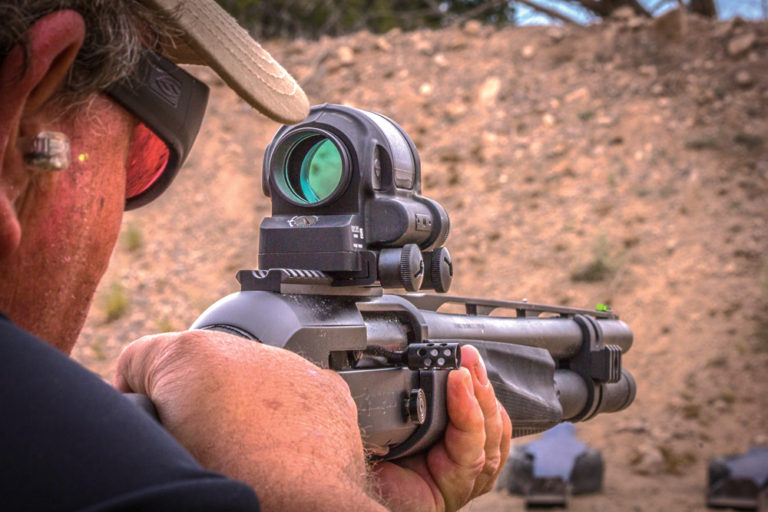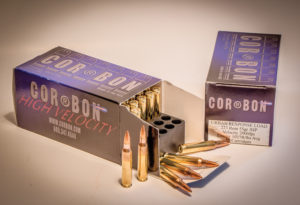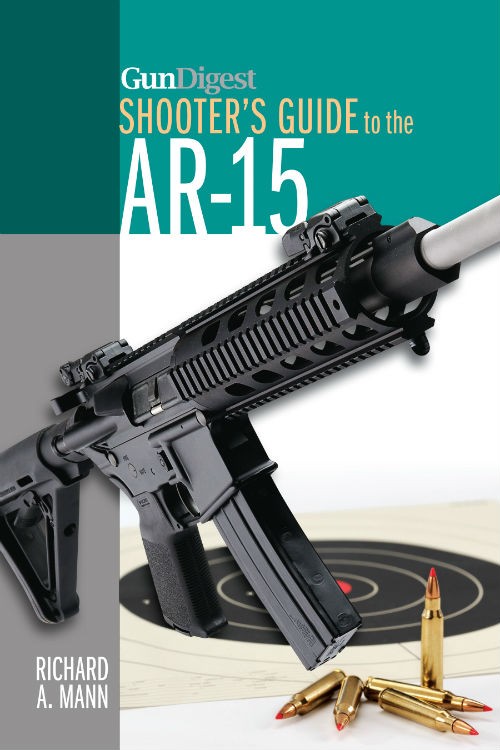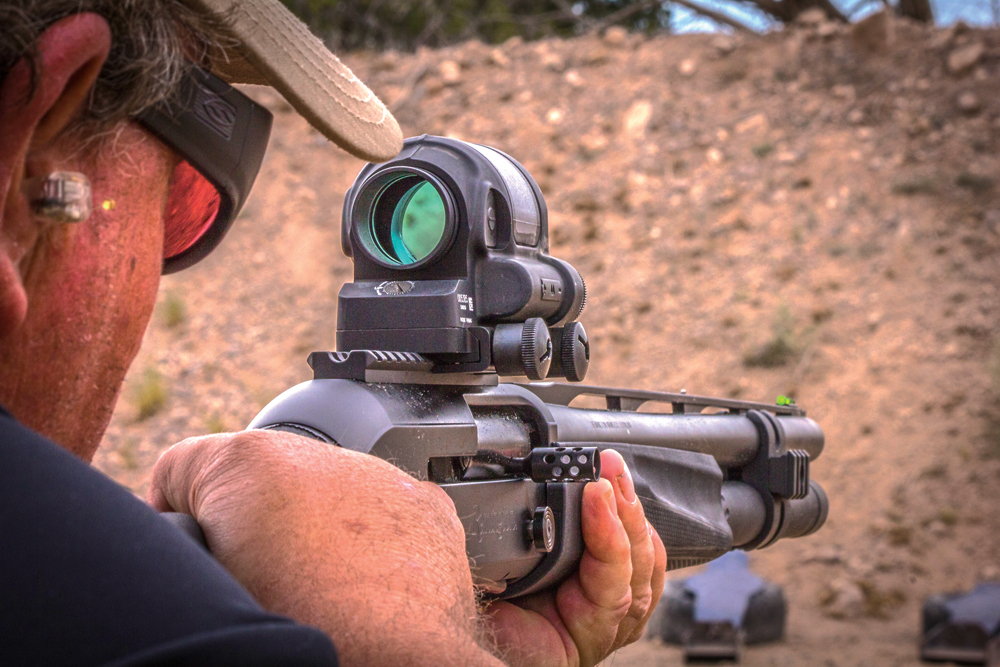
Which is the better choice for home defense?
Choosing a weapon for home defense is a serious matter, and as far as I’m concerned, a handgun should be an integral part of any home defense plan. Why? Unlike a shotgun or an AR, handguns are easy to keep with you at all times. With a long gun, you’ll have to go fetch it when the balloon goes up. A handgun, however, does not constitute a comprehensive home defense plan. Handguns are personal defense weapons, and while one might very well be needed during a home protection scenario, if a long gun is wielded with authority and precision, the handgun will remain in its holster.
Both the AR and the shotgun have more reach than a handgun. Both deliver a lot more power, and both are easier to shoot with precision. I’m not a shotgun kind of guy. This is not in any way a reflection on the usefulness of the weapon system—it’s just representative of my taste in firearms. As biased as I might be, I appreciate and understand that in some cases the shotgun might be the best answer.
Basic Differences

The shotgun has long been a popular weapon for home defense. Some would argue this is due to its suitability to the role, but I believe it’s more likely due to the shotgun’s prevalence in society. Uncle Bob likely kept a shotgun behind the kitchen door because a shotgun was the only gun Uncle Bob had. Carbines—short rifles—have always cost more than shotguns and require more training for most folks to shoot them accurately. For the one-gun homestead, a high-power rifle was not the best tool for small game or flying foul.
Just because old wives tell us the shotgun is the best home defense gun does not make it so. Many of those old wives were probably married to Uncle Bob. At the basic level, the shotgun allows for a slight bit of point of aim/point of impact variance. This is because it disperses shot into a pattern that increases in size with range. The farther the target is away from the shotgun, the easier it is to hit. But everything has its limits, and the shotgun’s limits are not that far away.
Ballistic Differences
Ballistically speaking, the AR-15 carbine chambered for the .223 Rem. is more powerful than the shotgun. With a nominal impact velocity of 1,250 feet per second (fps), a single 54-grain 00 buck pellet will have 187 ft.-lbs. of kinetic energy. This is very similar to a single bullet fired from a high velocity .22 LR. If you can hit your attacker with every pellet in a 00 buckshot blast, it would be like shooting the bad guy a bunch of times, all at the same time, with a .22.
On the other hand, a 55-grain bullet fired from a .223 AR-15 carbine will strike with about 1,000 ft.-lbs. of energy. But all that energy will be directed at a single spot. To further exaggerate the difference in terminal performance, shot pellets are non-expanding; they will only punch a caliber-size hole through the bad guy. A centerfire rifle bullet will expand and sometimes violently fragment, creating a much more ferocious and painful wound. Of course shotguns can also fire slugs, and slugs are wickedly powerful projectiles that make big holes and are hard to stop. A ¾-ounce slug from a 12 gauge will deliver about twice the energy of any .223 Rem. load and will make a very, very big hole going in and coming out. Hit your target with a slug and it will suffer. And as Sir Isaac Newton so aptly explained, so will your shoulder.
Ammunition Options
 Whether it’s shot or slug, shotguns throw a large payload. Nine 00 buck pellets will weigh about 480 grains, which is about nine times heavier than a .223 bullet. To push this cargo out the barrel it takes lots of energy, and that push goes both ways. In short, shotguns kick hard—about eight to 10 times harder than an AR-15. Recoil is the prime detractor to the shotgun; it’s the reason many cannot shoot it well and the reason many do not want to shoot it at all.
Whether it’s shot or slug, shotguns throw a large payload. Nine 00 buck pellets will weigh about 480 grains, which is about nine times heavier than a .223 bullet. To push this cargo out the barrel it takes lots of energy, and that push goes both ways. In short, shotguns kick hard—about eight to 10 times harder than an AR-15. Recoil is the prime detractor to the shotgun; it’s the reason many cannot shoot it well and the reason many do not want to shoot it at all.
Aside from recoil, there are other considerations. The most popular defensive load for the shotgun is 00 buck. These 00 buck pellets will penetrate very deep—about 20 inches in 10-percent ordnance gelatin. These pellets are also capable of passing through most interior walls and easily through any, if not every, wall in a mobile home. If you’re worried about hitting a family member in an adjoining room or if you live in a trailer park, double-ought buckshot is probably not the way to go. The solution can be smaller shot; at conversational distances, #6, #7 and even #8 shot is unimaginably destructive to the human body.
The downside to all shot shells is range. Much past 25 yards, shot becomes terminally ineffective for two reasons. First, the pattern size expands to the point that a large portion of your shot will miss the target, and the resulting wound is less concentrated. Secondly, round shot is not very ballistically efficient and loses energy fast. If the engagement distance extends past 30 yards, it would be advisable to switch to a slug.
Finally, it only makes good sense to choose the ammo for your AR with the same care and concern. To eliminate penetration through interior and exterior walls, look to fragilely constructed varmint bullets or specialty loads like those in the Hornady TAP line. If, however, you are a hopeless bachelor living alone out past the landfill, you can opt for any shotgun or AR load you like. In fact, in the most rural settings, deep-penetrating loads might be a good idea; sometimes four-legged predators must be dealt with, too.
The Sensible Choice

Practically speaking, there’s not a great deal of difference between an AR and a shotgun for home defense. It is unlikely you will need the capacity or extended reach of the AR. Of course as soon as that’s said, you’ll be accosted by a horde of zombies charging across the back pasture. Shotguns are not known as precision weapons, but if equipped with good combat sights and loaded with quality slugs, they can easily keep three shots inside a 3-inch circle at 50 yards. If you choose your ammunition wisely, from a pure ballistic standpoint, it’s a toss up. The simple answer is to choose the one you can shoot the best. If you find the shotgun intimidating, it will never be a good choice. All the same, you might not be the person who has to wield it. The need to deploy the long gun in a defensive situation could fall on another member of the household.
ARs are generally more compact, often lighter and much easier for most to shoot with precision. If recoil is a big deal to you and your family but you prefer the shotgun, don’t overlook the 20-gauge. It has less recoil but is still very effective.
It might surprise you to learn my primary home defense long gun is a Smith & Wesson M&P15-22 loaded with a magazine full of CCI Stingers. No, a .22 is not the most lethal long arm, but everyone who lives in my home can operate it with enough precision and speed to deal with anything from a bad guy to a rabid fox. The key is not to rely on a home defense plan built around one gun. That’s why I also have a Mossberg 590A1 12-gauge in the den and a handgun basically on me at all times.
This article appeared in the August 2015 issue of Gun Digest the Magazine. Click here to download the full issue.
More from Richard Mann:
 Gun Digest Shooter's Guide to the AR-15
Gun Digest Shooter's Guide to the AR-15
The Gun Digest Shooter’s Guide to the AR-15 by Richard A. Mann presents a comprehensive and user-friendly look at today’s most popular modern sporting rifle. Among a wide variety of topics, the firearms expert and noted author provides helpful ammunition and accuracy tips, an explanation of the AR platform, a wide range of AR-15 applications, and much more, enhanced by 250 black and white photos. Keep up with the increasing popularity of the versatile AR-15 with this indispensable shooter’s guide. Get your copy









I think you have that backwards. The shot from a shotgun isn’t going into the neighbors house, I wouldn’t use an AR15 for precisely that reason… it is a (relatively) high powered cartridge with a muzzle energy around 1600 ft/lbs – which is twice a .44 magnum. The advantages of a shotgun are that they shoot a wide pattern, so the owner (all hyped up on adrenaline and probably scared) doesn’t need to be as precise as one would need to be aiming a pistol or rifle. Also, the bead is pretty fast and easy to get on target, no futzing around with lining up the sights – but you can put Red Dots and Trijicon style sights on a shotgun too.
I don’t believe recoil is a factor in a high stress situation (going back to adrenaline), but if you have a problem with 12 gauge recoil, don’t use one, buy a 20 gauge (or a 16, or a 410). Magazine capacity is another one, I always wonder if we’re talking about a burglary or home invasion or a shootout with a platoon of MS13. Extended tubes on shotguns are easy to install and if 7 to 9 are insufficient, there are shotguns out there with capacities in the teens.
As people have said, use what you’re comfortable and use best, but I think the shotgun is a more prudent option.
Like so many defense with firearms articles, the “take away” or “bottom line” is simple: “Have competence with the weapon chosen, and be willing to use it if there is no other way.”
Uncle Bob had a shotgun. Richard Mann, the author, has a self-loading .22 so anyone–presumably children–can use it, AND an AR, which as an ex-soldier and law enforcement officer he is proficient with, AND a Mossberg 590A1, AND a handgun on his person… Um. Ok. A long time ago, it used to be a cliché to “beware the man with one gun.” Those days are gone for good, I’d guess.
The weapons I know anyone in my household can use are a Ruger LCR revolver (lighter, non-stacking double-action trigger), an M1 carbine with a 15-round magazine loaded with Hornady “Critical Hype” ammunition, and a Beretta Cx4 9mm carbine. Not a .22. Not an AR either (ever fired one indoors?! Bit loud. Of course, the same is true for a shotgun.)
A “home defense situation” as noted by nimrod666, Mikial, Ridjrunner, and other respondents, will be a close range affair. Otherwise it is not a home defense situation, but something different. So range is a specious argument. A long gun can be fired more accurately than a handgun by most people. But a handgun is smaller, and is easier to transport inside the confined spaces of a home, apartment, or similar interior spaces. The argument for the shotgun boils down to a) its reputation as a “fight stopper” and the negation of the various “enough gun” stopping power arguments, and b) it does have a high intimidation factor. No one can rely on point b), but point a) stands. A shotgun is a close-range, low capacity firearm. What it has going for it is its tremendous load of buckshot. A 20 gauge might be better than a 12 gauge, particularly for recoil averse people, but there are more loads developed for the 12, including “Win Lite” and “low recoil” and “tactical” loads that offer lighter recoil, tighter patterns, or both. A carbine has greater firepower with a detachable magazine, higher capacity, and greater hit probability than a pistol. Something like an NFA SBR might be a great HD firearm in that it could combine the virtues of the pistol and the carbine, but there’s that big tax stamp and waiting for the paperwork or chief LEO to sign off.
A 20 gauge shotgun with bird shot is ideal inside a home. Especially if others live in the house. It is less likely to kill beyond the intended target. A couple of interior walls will stop it and even one made of sheetrock will make it unlikely to be fatal. An ounce of lead delivered to the chest is an ounce no matter the size of the shot. The target will not be able to count the shot pellets and the shock will be the same as a slug of the same weight. The problem with the 5.56 is over penetration. You are responsible for the damage caused by your bullet. When it exits your house it is still your responsibility. It can penetrate several interior walls and still be lethal. You could very well be a bigger threat to your friends, neighbors and family than the intruder. It can easily go through a brick veneer wall and kill outside your home. I own several firearms including an AR-15 and it would be my last choice for home defense. I would choose my shotgun first and a handgun second.
20ga is a good idea. Birdshot is not. Birdshot will not penetrate to the vitals. it will make an ugly surface wound and that’s about it.
Anything that will stop a badguy will also go through drywall. A light (45gr) 5.56 will tumble and start breaking up after only 2-3 layers of sheetrock. A .45 handgun with 200 grain hollowpoints will go through more interior and exterior walls than either a shotgun or a 5.56.
Hit the face and you will poke out eyeballs, put many holes in the windpipe, and slice open major arteries on the sides of the neck leading to rapid and massive blood loss. Who is gonna fight after having that happen to them??
A fun article, even if i don’t quite follow some of the author’s reasoning. A home defense weapon is one you will use within the walls of your home, where ranges are measured in feet not yards, so most of the arguments against a shotgun don’t really apply, at least not in my line of reasoning. But, it does get your mind going in terms of thinking about what you use to secure your home and how you use it. So a great article from that perspective.
We all like to tell each other what we personally use, and it’s likely most of us don’t really care except for the fun factor of telling and listening, but for what it’s worth, I have a Saiga 12 Ga loaded with 00 in a rack alongside my mattress, and a Glock 21 on the nightstand. Both have lights. My wife has a 12 gauge pump with a light, but really prefers her Beretta 92. Period. We are both proficient with our weapons fo choice, and we are both psychologically prepared to use them in a life-or-death situation.
The title is home defense but the article is written toward long range property defense against armed intruders who shoot from the road. It is my understanding that the ONLY legal use of a firearm in self defense is in a state of immediate danger to life and limb. If you are in your house and the intruder is 25 yards away, they are not inside or even at most homes. At least not the ones anyone I know owns. At those ranges self defense would be very difficult to claim unless the intruders were already firing. Many shotguns, out to about ten yards will produce a pattern a couple of feet or less across, the pattern decreasing with closeness to about two inches. You have to aim a shot gun, just like a rifle, at personal protection or inside the house distances. It isn’t just point and pull at those distances. If I had my choice I would take nine projectiles covering two to ten inches over one covering 0.224 inches to stop an intruder. Under that kind of stress, precision aimed fire is not going to be my long suit.
I noticed that myself. I’m not sure how big this guy’s house is, but his arguments against a shotgun because they scatter too much after 25 yards. I’m not sure how many homes have hallways the extend 25 yards, but mine sure doesn’t.
For most home defense we don’t need telescopic sights, lasers, etc. If you plan a defense with these in mind you will be anticipating a long range solution. If it were to come up in court it may be a problem. However, where I live, when I look out my back door all I can see for hundreds of yards is my horse pasture and brush. Sometimes at night I can hear Bigfoot out there. So, I have several options ready. But, if someone were too far for my handgun I would let it be.
I opt for a 20 gauge pump with a 22″ barrel, improved modified choke with BB loads, my preference is to have a firearm that is capable of 5 to 50 foot stopping power and if needed as my old police buddies like to say, then you use the thing as a club, if needed. I have patterned this firearm at several ranges and am confident in its ability should the awful occasion arise. In the meantime, I have shot clays, hunted small game and deer when I outfit the shotgun with another one of the appropriate barrel and or choke combos.
I find the suggestion of fancy optics (as seen in the picture leading into the article) for a home defense long gun a bit concerning as their practical use in 20 foot to “bad breath” distances within a home is at the very least questionable. I agree that the shotgun, unplugged to its maximum capacity, is a good option versus an AR and its tendency to over-penetrate and its requirement to be relatively more carefully aimed. I am liking the idea of a shotgun with either a laser or at least a trijicon type front sight. In low light, very short range encounters, engagements are most apt to be the point-and-shoot variety. Good article though.
Nice article, thanks. What is the optic on the shotgun in the first photo?
Decoration. LOL